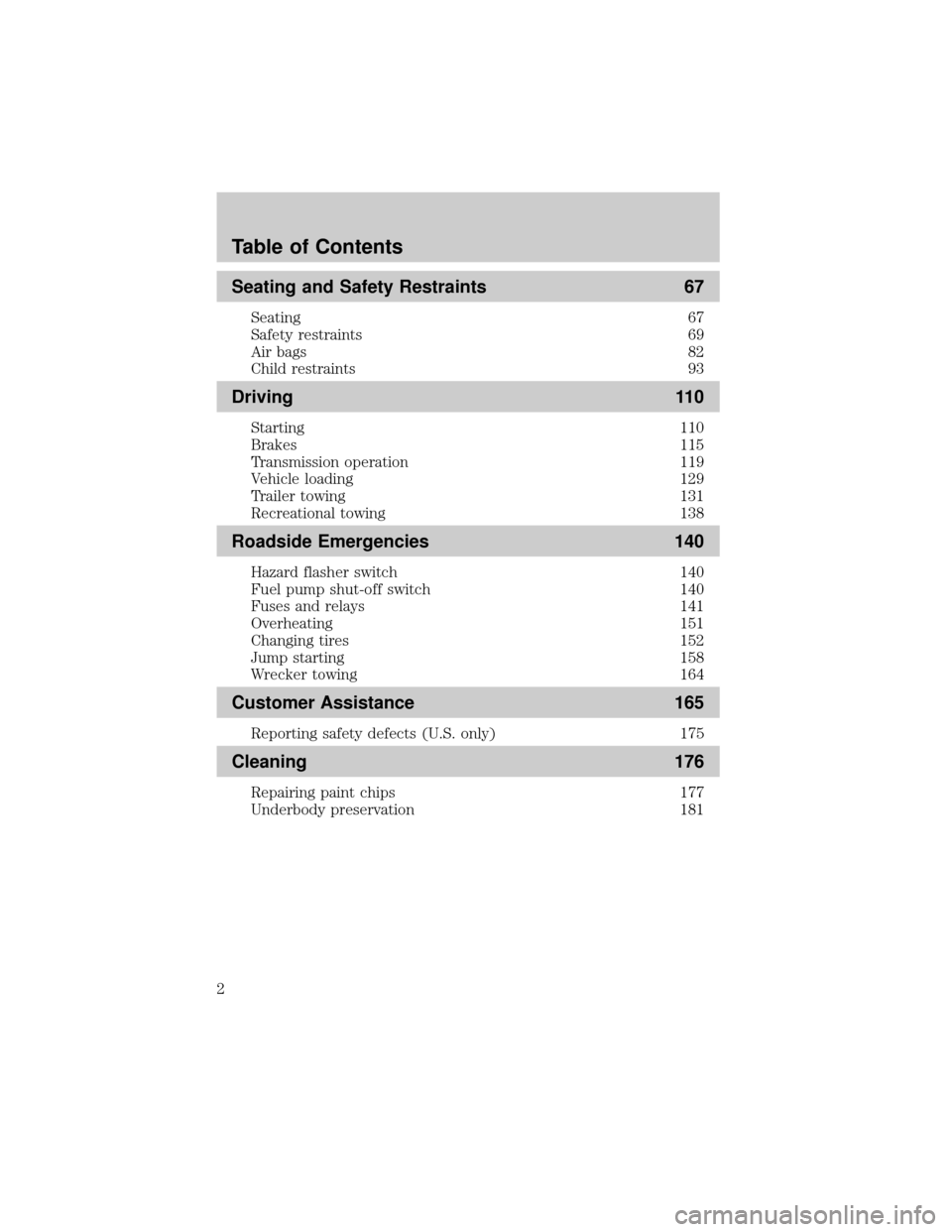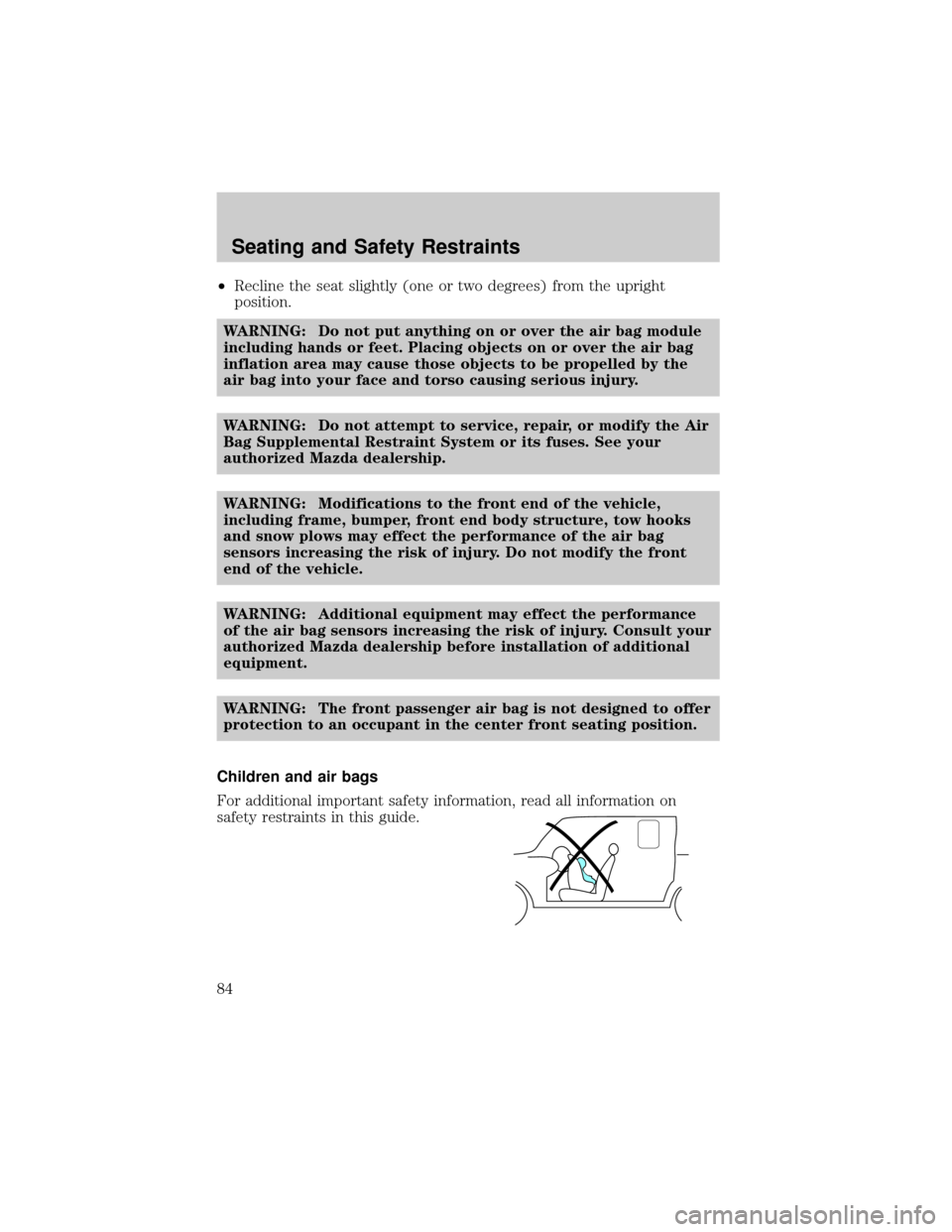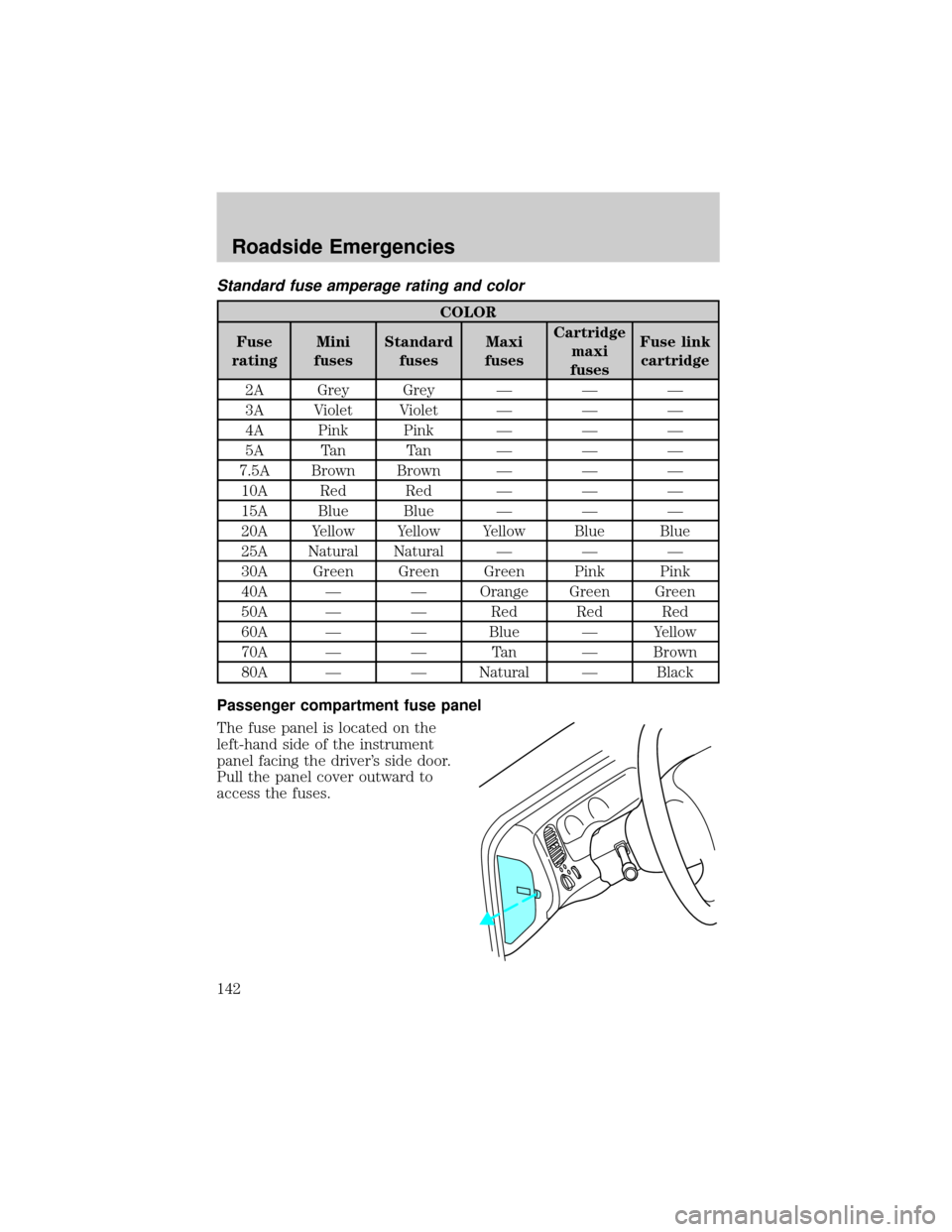fuses MAZDA MODEL B-SERIES 2003 Owners Manual (in English)
[x] Cancel search | Manufacturer: MAZDA, Model Year: 2003, Model line: MODEL B-SERIES, Model: MAZDA MODEL B-SERIES 2003Pages: 245, PDF Size: 2.33 MB
Page 2 of 245

Seating and Safety Restraints 67
Seating 67
Safety restraints 69
Air bags 82
Child restraints 93
Driving 110
Starting 110
Brakes 115
Transmission operation 119
Vehicle loading 129
Trailer towing 131
Recreational towing 138
Roadside Emergencies 140
Hazard flasher switch 140
Fuel pump shut-off switch 140
Fuses and relays 141
Overheating 151
Changing tires 152
Jump starting 158
Wrecker towing 164
Customer Assistance 165
Reporting safety defects (U.S. only) 175
Cleaning 176
Repairing paint chips 177
Underbody preservation 181
Table of Contents
2
Page 84 of 245

²Recline the seat slightly (one or two degrees) from the upright
position.
WARNING: Do not put anything on or over the air bag module
including hands or feet. Placing objects on or over the air bag
inflation area may cause those objects to be propelled by the
air bag into your face and torso causing serious injury.
WARNING: Do not attempt to service, repair, or modify the Air
Bag Supplemental Restraint System or its fuses. See your
authorized Mazda dealership.
WARNING: Modifications to the front end of the vehicle,
including frame, bumper, front end body structure, tow hooks
and snow plows may effect the performance of the air bag
sensors increasing the risk of injury. Do not modify the front
end of the vehicle.
WARNING: Additional equipment may effect the performance
of the air bag sensors increasing the risk of injury. Consult your
authorized Mazda dealership before installation of additional
equipment.
WARNING: The front passenger air bag is not designed to offer
protection to an occupant in the center front seating position.
Children and air bags
For additional important safety information, read all information on
safety restraints in this guide.
Seating and Safety Restraints
84
Page 119 of 245

WARNING: Loaded vehicles, with a higher center of gravity,
may handle differently than unloaded vehicles. Extra
precautions, such as slower speeds and increased stopping
distance, should be taken when driving a heavily loaded vehicle.
AUTOMATIC TRANSMISSION OPERATION (IF EQUIPPED)
Brake-shift interlock
This vehicle is equipped with a brake-shift interlock feature that prevents
the gearshift lever from being moved from P (Park) when the ignition is
in the ON position unless the brake pedal is depressed.
If you cannot move the gearshift lever out of P (Park) with ignition in
the ON position and the brake pedal depressed:
1. Apply the parking brake, turn
ignition key to LOCK, then
remove the key.
2. Insert the key and turn it to
OFF.Apply the brake pedal
and shift to N (Neutral).
WARNING: In the ignition OFF position, the automatic
transmission shift lever can be moved from the P (Park)
position without the brake pedal depressed. To avoid unwanted
vehicle movement, always set the parking brake.
3. Start the vehicle.
If it is necessary to use the above procedure to move the gearshift lever,
it is possible that a fuse has blown or the vehicle's brakelamps are not
operating properly. Refer toFuses and relaysin theRoadside
emergencieschapter.
WARNING: Do not drive your vehicle until you verify that the
brakelamps are working.
Driving
119
Page 141 of 245

This switch is located in the front
passenger's footwell, by the kick
panel access cover.
To reset the switch:
1. Turn the ignition OFF.
2. Check the fuel system for leaks.
3. If no leaks are apparent, reset
the switch by pushing in on the
reset button.
4. Turn the ignition ON.
5. Wait a few seconds and return
the key to OFF.
6. Make another check of leaks.
FUSES AND RELAYS
Fuses
If electrical components in the
vehicle are not working, a fuse may
have blown. Blown fuses are
identified by a broken wire within
the fuse. Check the appropriate
fuses before replacing any electrical
components.
Note:Always replace a fuse with one that has the specified amperage
rating. Using a fuse with a higher amperage rating can cause severe wire
damage and could start a fire.
15
Roadside Emergencies
141
Page 142 of 245

Standard fuse amperage rating and color
COLOR
Fuse
ratingMini
fusesStandard
fusesMaxi
fusesCartridge
maxi
fusesFuse link
cartridge
2A Grey Grey Ð Ð Ð
3A Violet Violet Ð Ð Ð
4A Pink Pink Ð Ð Ð
5A Tan Tan Ð Ð Ð
7.5A Brown Brown Ð Ð Ð
10A Red Red Ð Ð Ð
15A Blue Blue Ð Ð Ð
20A Yellow Yellow Yellow Blue Blue
25A Natural Natural Ð Ð Ð
30A Green Green Green Pink Pink
40A Ð Ð Orange Green Green
50A Ð Ð Red Red Red
60A Ð Ð Blue Ð Yellow
70A Ð Ð Tan Ð Brown
80A Ð Ð Natural Ð Black
Passenger compartment fuse panel
The fuse panel is located on the
left-hand side of the instrument
panel facing the driver's side door.
Pull the panel cover outward to
access the fuses.
Roadside Emergencies
142
Page 143 of 245

To remove a fuse use the fuse puller tool provided.
The fuses are coded as follows:
Fuse/Relay
LocationFuse Amp
RatingPassenger Compartment Fuse Panel
Description
1 5A Power mirror switch
2 10A Daytime Running Lights (DRL), Back-up
lamps, Transmission, Passenger air bag
deactivation switch, Blower motor relay
3 7.5A Left stop/turn trailer tow connector
4 Ð Not used
5 15A 4x4 control module
6 2A Brake pressure switch
7 7.5A Right stop/turn trailer tow connector
8 Ð Not used
9 7.5A Brake pedal position switch
Roadside Emergencies
143
Page 145 of 245

Fuse/Relay
LocationFuse Amp
RatingPassenger Compartment Fuse Panel
Description
30 Ð Not used
31 Ð Not used
32 Ð Not used
33 15A Headlamps, Daytime Running Lamps
(DRL) module, Instrument cluster
34 Ð Not used
35 15A Horn relay (if not equipped with a Central
Security Module)
36 Ð Not used
Power distribution box
The power distribution box is
located in the engine compartment.
The power distribution box contains
high-current fuses that protect your
vehicle's main electrical systems
from overloads.
WARNING: Always disconnect the battery before servicing high
current fuses.
WARNING: To reduce risk of electrical shock, always replace
the cover to the Power Distribution Box before reconnecting
the battery or refilling fluid reservoirs.
If the battery has been disconnected and reconnected, refer to the
Batterysection of theMaintenance and specificationschapter.
Roadside Emergencies
145
Page 146 of 245

2.3L engine (if equipped)
The high-current fuses are coded as follows:
Fuse/Relay
LocationFuse Amp
RatingPower Distribution Box Description
1 50A** I/P fuse panel
2 Ð Not used
3 Ð Not used
4 Ð Not used
5 Ð Not used
6 50A** Anti-lock Brake System (ABS) pump
motor
7 30A* Powertrain Control Module (PCM)
8 20A* Central security module, Power door locks,
Remote entry
9 Ð Not used
10 Ð Not used
11 50A** Starter relay, Ignition switch
12 20A* Power windows
1234521 22 23 24
25 26 27 28
29 30 31 32
33 34 35 36
37 38 39 40
41 42 43 44
67891055
49 4854 53 52
515656 B
56 A
5050 B
50 A 47 4545 B
45 A
4646 B
46 A 11 12 13 14 15
16 17 18 19 20
Roadside Emergencies
146
Page 148 of 245

Fuse/Relay
LocationFuse Amp
RatingPower Distribution Box Description
44 Ð Not used
45A Ð Wiper HI/LO relay
45B Ð Wiper park/run relay
46A Ð Fuel pump relay
46B Ð Trailer tow relay
47 Ð Starter relay
48 Ð Auxiliary cooling fan relay
49 Ð Not used
50 Ð Not used
51 Ð Not used
52 Ð Not used
53 Ð PCM Diode
54 Ð PCM Relay
55 Ð Blower motor relay
56A Ð A/C clutch relay
56B Ð Front washer pump relay
* Mini Fuses ** Maxi Fuses
Roadside Emergencies
148
Page 149 of 245

3.0L and 4.0L engines (if equipped)
The high-current fuses are coded as follows:
Fuse/Relay
LocationFuse Amp
RatingPower Distribution Box Description
1 50A** I/P fuse panel
2 Ð Not used
3 Ð Not used
4 Ð Not used
5 Ð Not used
6 50A** Anti-lock Brake System (ABS) Pump
Motor
7 30A* Powertrain Control Module (PCM)
8 20A* Power door locks, Remote entry
9 Ð Not used
10 Ð Not used
11 50A** Starter relay, Ignition switch
12 20A* Power windows
13 20A* 4x4 motor
Roadside Emergencies
149